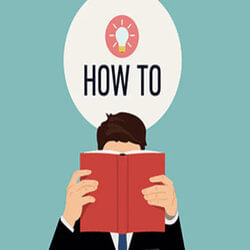UPSC Exam > UPSC Notes > Additional Study Material for UPSC > Nitin Singhania: Summary of Indian Theatre
Nitin Singhania: Summary of Indian Theatre | Additional Study Material for UPSC PDF Download
| Table of contents |

|
| Introduction |

|
| Classical Sanskrit Theatre |

|
| Folk Theatre |

|
| ➢ |

|
| Modern Indian Theatre |

|
Introduction
- Excavated ruins at Sitabena & Jogimara caves represent the world’s oldest amphitheatres.
- Bharat Muni’s Natya Shastra, written in the period between 200 BC & 200 AD and is the first formal treatise on dramaturgy. In it, ten types of play - from one-act play to ten acts have been described covering all aspects of classical Sanskrit literature.
Question for Nitin Singhania: Summary of Indian Theatre
Try yourself:Consider the following about classical Sanskrit theatre?
1. They always had happy endings.
2. The protagonist was male.
Which of the above is/are true:
1. They always had happy endings.
2. The protagonist was male.
Which of the above is/are true:
View Solution
Classical Sanskrit Theatre
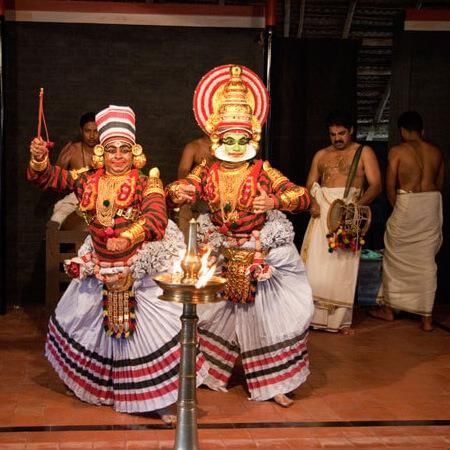 Sanskrit Drama
Sanskrit Drama
- Theatre in India began as a narrative art form.
- Sanskrit word ‘nataka’- derived from the root word ‘nata’ meaning a dancer.
- Rupaka, Drishyakvya & Preksakavya were others also used to describe drama.
- In ancient India, plays of two types:
(i) Lokadharmi: Realistic depictions of daily life.
(ii) Natyadharmi: Conventional plays with more stylised narration & overt symbolism. Natyadharmi dance pose
Natyadharmi dance pose - First example of classical Sanskrit drama- Sariputraprakarana by Ashvaghosh, an eminent philosopher. It was a nine-act play.
- Bhasa, another playwright- composed 13 plays between 4th-5th century B.C.
- Sudraka- first to introduce the essence of conflict in his play Mricchakatika. This play featured a hero, heroine & an antagonist for the first time.
- Kalidasa- most popular among Sanskrit playwrights.
- His three works - Malavikagnimitra, Vikramorvashi & Shakuntalam -finest examples and portray the eternal conflict between desire & duty.
- Other examples - Uttaramacharitra and Mahaviracharitra by Bhavabhuti, Mudrarakshasa by Visakhadatta, and Ratnavali by Harshavardhan.
- As per classical Sanskrit tradition, plays were categorised into ten types -
namely Anka, Bhana, Dima, Ithamgra, Nataka, Prahasana, Prakarna, Svakama, Vithi and Vyayog. - Natya Shastra describes only two of these - Nataka & Prakarna.
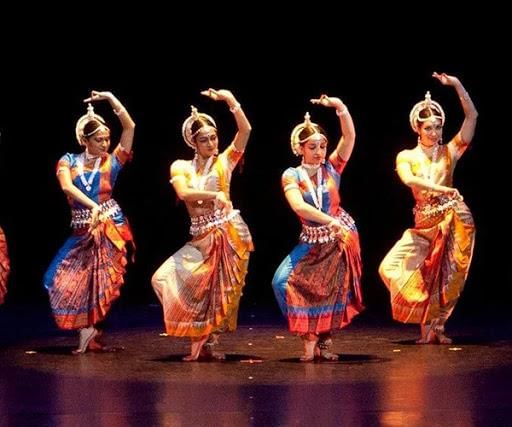 Natya Shastra
Natya Shastra - Classical Sanskrit play had some rigid conventions:
(i) Were four to seven-act Slavs.
(ii) Always had happy-endings.
(iii) The protagonist was male who would always achieve the object of his desire at the end.
(iv) Well defined opening, progression, development, pause, and conclusion. - Sanskrit plays followed ritualistic progression as follows:
(i) The play started with Purva-raga i.e. pre-play rituals performed behind the curtain.
(ii) After this, Sutradhar (stage manager & director), entered the stage to worship the deity dressed in white.
(iii) After that, the leading lady was summoned and was Sutradhar announced time and place of the play. - Theatre accommodated four hundred persons.
- Stages two-storeyed, upper floor for representing the celestial sphere & lower one represented terrestrial sphere.
- Curtains were used & masks weren’t.
- Characters in Sanskrit plays were classified into three kinds:
(i) Nayaka (Hero or the Protagonist)- males- could be Lalita (Kind-hearted), Shanta (Calm & composed), Uddhata (Agitated or arrogant) etc. The hero may also be ‘Pratinayaka’ (Antagonist) like Ravana, Duryodhana, etc
(ii) Nayika (Heroine)- females- could be queens, friends, courtesans (ganika), divine lady (Divya).
(iii) Vidusaka (Clown), the comic character plays a vital role in the plays. He is the noble and good-hearted & friend of a hero who questions the prevailing social norms through satire and spoke Prakrit traditionally.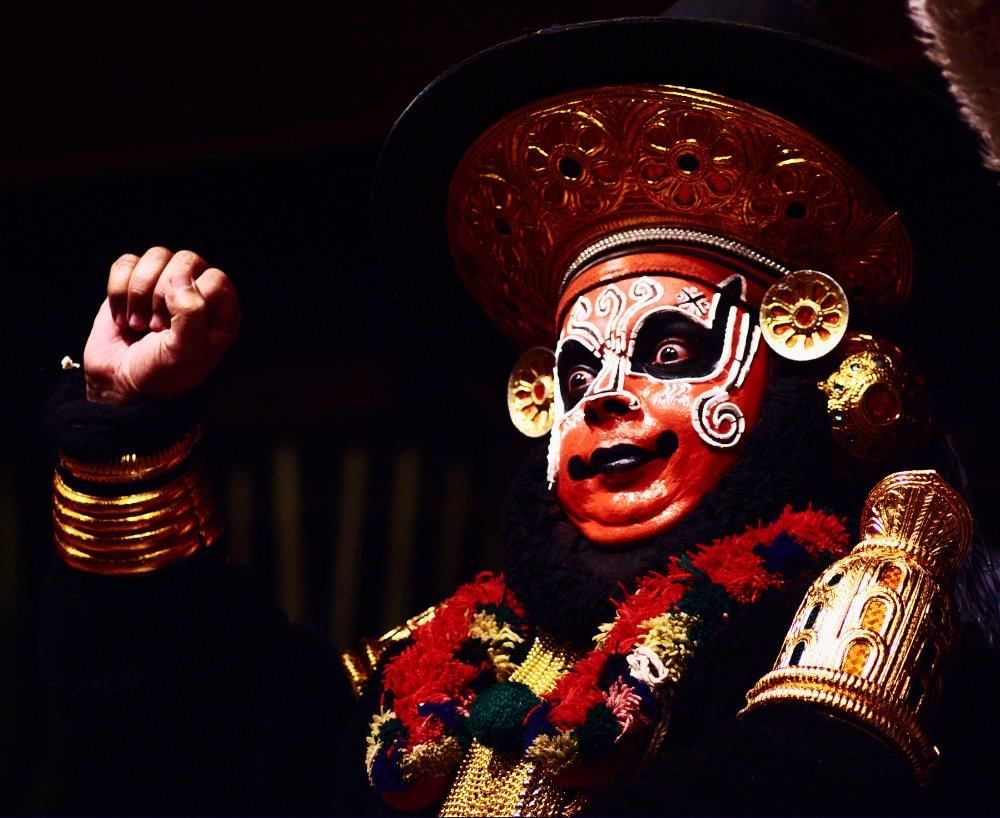 Vidusaka
Vidusaka
➢ Reasons for the decline of Sanskrit Theatre
- Sanskrit dramatists began to diverge towards poetry.
- The rigid orthodoxy of Sanskrit theatre restricted the creative space of new playwrights.
- As Sanskrit became more embellished, it lost popularity among the masses.
- It was increasingly confined to the religious sphere.
- With the advent of Muslim rulers, Sanskrit theatre took a definite backseat, as dance and music gained patronage.
Question for Nitin Singhania: Summary of Indian Theatre
Try yourself:Which of the following is not correctly matched?
View Solution
➢ Koothiyattam (Koodiyattam) Koothiyattam
Koothiyattam
- India’s oldest continuing form of theatre.
- Has survived since 10th century A.D. in Kerala.
- Completely adheres to rules laid down in Natya Shastra.
- The traditional privilege of Chakyar & Nambiar castes of Kerala.
- Performed in Sanskrit, Prakrit, and Malayalam, with Mizhavu and Edakka providing the background music.
- Begins with Nirvahana, a recollection of the past events of the story.
- Then the story unfolds in a leisurely fashion with commentaries on social, philosophical, and political behaviour.
- Marsi Madhu Chakyar- leading exponent.
Folk Theatre
- Traditional folk theatre- reflects various aspects of local lifestyle including social norms, beliefs & customs.
- Sanskrit theatre- More urban-oriented & sophisticated
- Folk theatre- Rural roots & rustic flavour was reflected in the dramatic style involved.
- Folk theatres of 15th - 16th century A.D.- devotional themes. Later they started adopting love ballads and accounts of local heroes and thus adopted more secular tones.
- Indian folk theatre-
Classified into three categories as follows:
(i) Ritual Theatre
(ii) Theatre of Entertainment
(iii) South Indian Theatre
➢ Ritual Theatre
Became popular during the Bhakti movement as a means for communicating faith to God.
Some of the popular examples include:
1. Ankia Nat
- Traditional one-act play of Assam.
- Started by famous Vaishnava Saint Shankaradeva and his disciple Mahadeva in 16th century A.D.
- Performed in the style of an opera.
- Depicts the life of Krishna.
- Sutradhar or narrator is accompanied by a group of musicians called Gayan Bayan Mandali who play the ‘khol' and cymbals.
- Unique feature- use of masks.
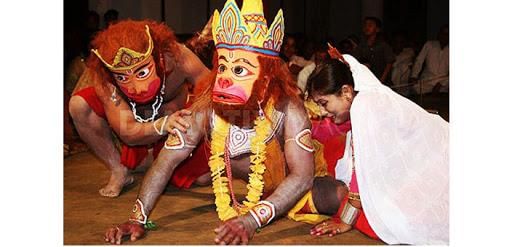 Ankia Nat
Ankia Nat
Question for Nitin Singhania: Summary of Indian Theatre
Try yourself:In which of the following theatre form, even the males’ roles are played by female actors?
View Solution
2. Kala
- Ancient folk theatre of the Vaishanvite tradition.
- Lifes and incarnations of Vishnu.
- Popular branches- Dashavatar Kala, Gopal Kala and Gaulan Kala.
3. Ramlila
- Popular folk theatre in the region of Uttar Pradesh.
- Enactment of Ramayana during the period before Dussehra.
- Performed by male actors, who perform the role of Sita as well.
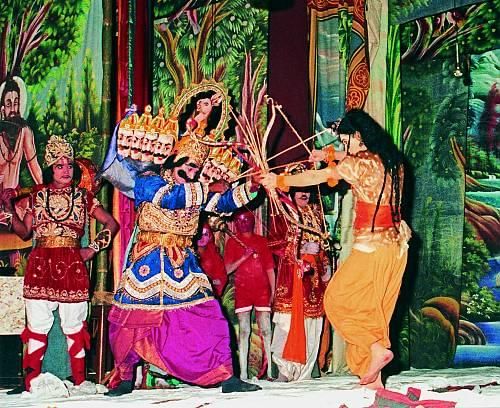 Ramlila
Ramlila
4. Raslila
- Dance drama enactment of love stories of Krishna and Radha, popular in Gujarat.
 Raslila
Raslila
5. Bhuta
- Bhuta, which means spirit, is a traditional practice of worshipping dead ancestors, prevalent in the Kannada district of Karnataka.
6. Ramman
- Ritualistic theatre of Garhwal region of Uttarakhand.
- Dedicated to Bhumiyal Devta, the local deity.
- Listed in UNESCO’s Representative List of Intangible Cultural Heritage of Humanity.
- People of Bhandari caste wear sacred mask symbolizing Narasimha (half-man and half-lion).
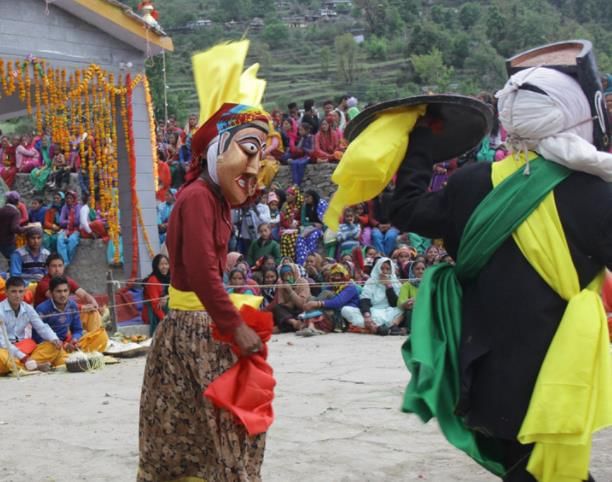 Ramman
Ramman
Question for Nitin Singhania: Summary of Indian Theatre
Try yourself:Which of the following is a reason for the decline in Sanskrit theatre?
View Solution
➢
Theatres of Entertainment- This form- more secular in narration & storytelling.
- Focused on stories of love, valour and sociocultural traditions.
1. Bhavai
- Folk theatre form of Gujarat & Rajasthan.
- Regions of Kutchh & Kathiawar.
- Extensive use of dance to narrate a series of small plays, known as Vesha or Swanga.
- Theme- Romantic.
- Accompanied by semi-classical music, played with Bhungala, Jhanjha & tabla.
- Sutradhara is known as Nayaka.
 Bhavai
Bhavai
2. Daskathia
- Odisha
- There are two narrators - Gayaka, chief singer & Palia, co-narrator.
- Narration- accompanied by dramatic music composed using a wooden musical instrument called Kathia.
- Close variant- Chhaiti Ghoda, which uses - dhol & mohuri - & three nanators.
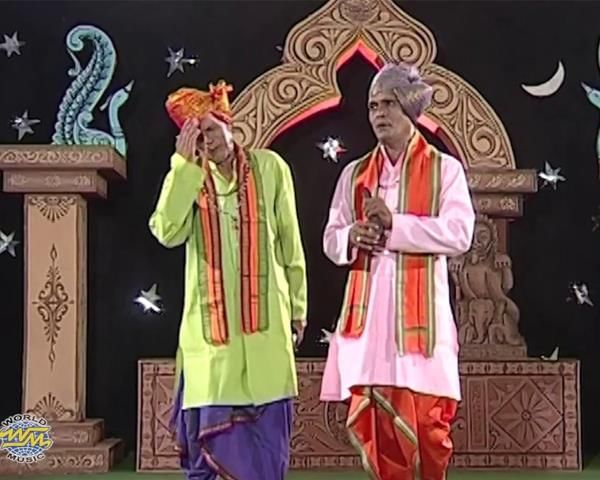 Daskathia
Daskathia
3. Garodas
- ‘Garoda’ community of Gujarat.
- Uses painted pictures to narrate stories of romance and valour.
4. Jatra
- Eastern India
- Is an open-air performance that was initiated by Vaishnava saint Sri Chaitanya.
- He used Jatra to propagate teachings of Krishna, during his travels through rural Bengal.
- Variants- Rama Jatra, Shiv Jatra & Chandi Jatra.
- In Odisha, a popular form of street theatre known as Sahi Jatra is prevalent.
5. Kariyila
- Open-air theatre.
- Foothills of Himachal Pradesh.
- Staged during village fairs and festivals at night.
- The performance comprises a series of small plays & skits.
6. Maach
- Malwa in Madhya Pradesh.
- Originated in Ujjain (17th century A.D).
- Based on mythological themes.
- Later, included romantic folk tales.
- Unique feature- dialogues, which are delivered in the form of couplets known as Rangat Dohas.
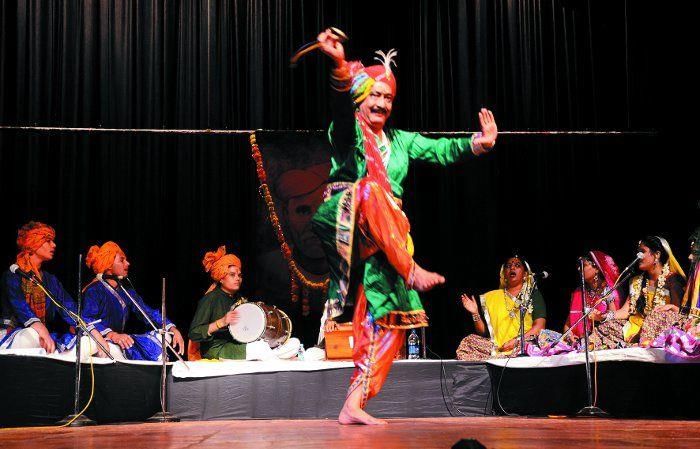 Maach
Maach
7. Nautanki
- An offshoot of Swang.
- A most popular form of theatre in North India, which finds mention in Abul Fazl’s Ain-e-Akbari.
- Themes- historical, social and folk tales.
- Dialogues are delivered in lyrically, accompanied by beats of a drum called Nagara.
- Two schools of Nautanki seated around Kanpur & Lucknow gained importance.
8. Oja-Pali
- Unique narrative theatre form of Assam.
- Associated with the festival of Manasa or serpent goddess.
- Narration is a prolonged affair, with three distinct parts - Baniya Khanda, Bhatiyali Khanda and Deva Khanda.
- Oja- the main narrator & Palis are the members of the chorus.
 Oja-Pali
Oja-Pali
9. Powada
- Lauds the heroic deeds of Shivaji.
- Are operatic ballads depicting stories of valour & sung by folk musicians known as Gondhalis and Shahirs.
- Popular in Maharashtra.
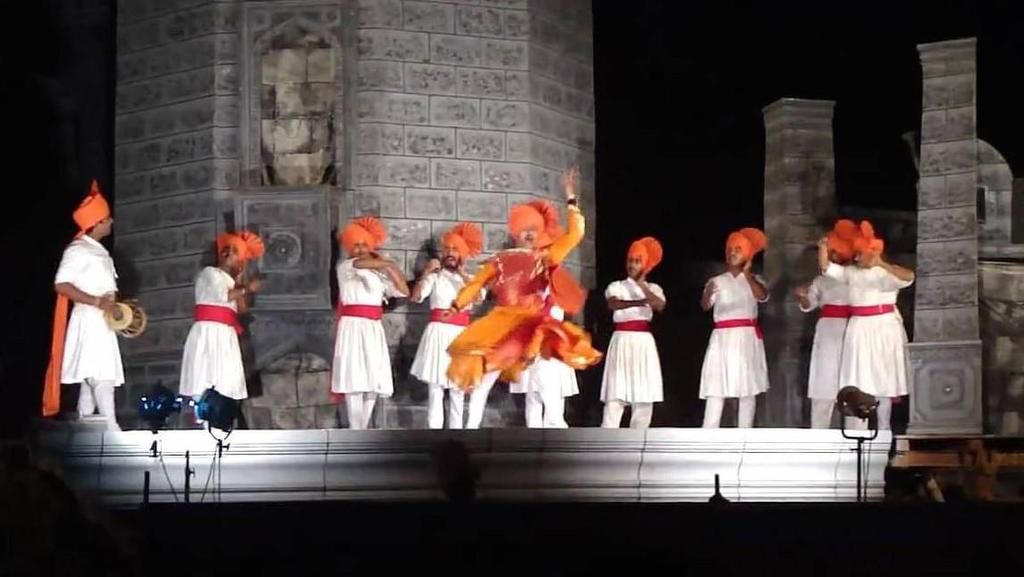 Powada
Powada
10. Swang
- Punjab and Haryana.
- Musical dramas, sung through verses, accompanied by the music of ektara, harmonium, sarangi, dholak & khartal.
11. Tamasha
- Maharashtra
- Known for its humour and erotic content.
- Unique feature- The presence of female actors, who play even male roles.
- Accompanied by Lavani songs.
12. Villu Pattu
- ‘Villu Pattu’ means bow-song.
- Popular in Deccan.
- Stories of Ramayana are narrated using bow-shaped instruments.
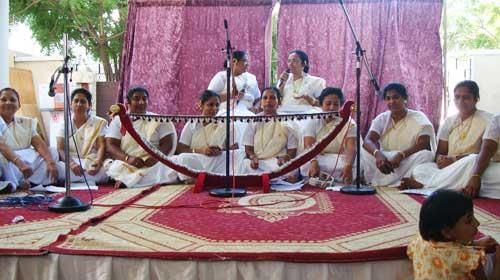 Villu Pattu
Villu Pattu
13. Bhand Pather
- Jammu and Kashmir.
- Involves contemporary social satire or even mythical stories.
- Secular in outlook, although performed by Muslims.
- Has music, dance & drama.
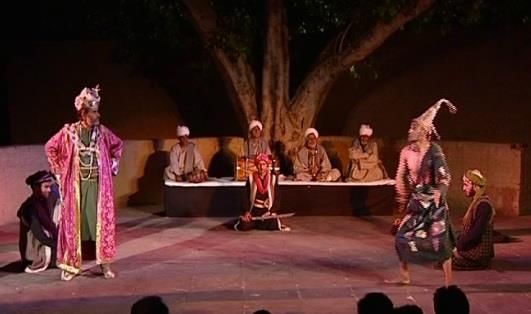 Bhand Pather
Bhand Pather
14. Bhaona
- Folk Theatre of Assam, especially the Majuli Island.
- To spread religious & moral messages.
- It is a presentation of Ankia Naat and Vaishnavite themes are common.
- Sutradhar (Narrator) narrates play & sings verses from holy texts.
- Songs & music are a part of it.
15. Dashavatar
- By farmers of Konkan region, notably Sindhudurg (Maharashtra) & North Goa.
- To honour ten incarnations of Lord Vishnu.
- Has two parts: ‘poorvaranga’ (initial part) & ‘Uttara-ranga’(the second part which is the main act and is based on mythological stories).
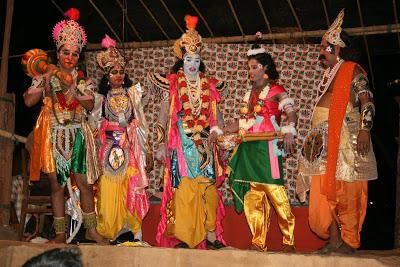 Dashavatar
Dashavatar
16. Naqal or Bhand
- Is mimicry based performance.
- In Punjab & adjoining areas.
- The performing artist is often called ‘Behroopiya’ or ‘Naqalchi’ (impersonator). He uses comedy, absurdities, wit & humour.
- Performed by two artists.
Question for Nitin Singhania: Summary of Indian Theatre
Try yourself:Which is the oldest continuing form of theatre in India?
View Solution
 |
Download the notes
Nitin Singhania: Summary of Indian Theatre
|
Download as PDF |
Download as PDF
➢ Theatres of South India
- When Sanskrit classical theatre started to decline in North India (around 8th century A.D), it gained popularity in southern parts India.
- The speciality of theatrical traditions of South- emphasis on dance as compared to the emphasis on music in Northern India.
- Some popular theatres of South India are explained below.
1. Yakshagana
- Oldest theatre traditions.
- Prevalent till date in Andhra Pradesh & Karnataka.
- Originated in royals courts of Vijaynagar Empire & was performed by a particular community called Jakkula Varu.
- Descriptive dance-drama enacted by a single artist.
- Popular variants- Laliti ln Maharashtra, Bhavai in Gujarat, and Gandharva Gana in Nepal.
- Popular Yakshagana Plays include Garudachalam by Obayya Mantri, Krishna-Hiramani by Srinddha & Sugriva & Vijayam by Rudra Kavi.
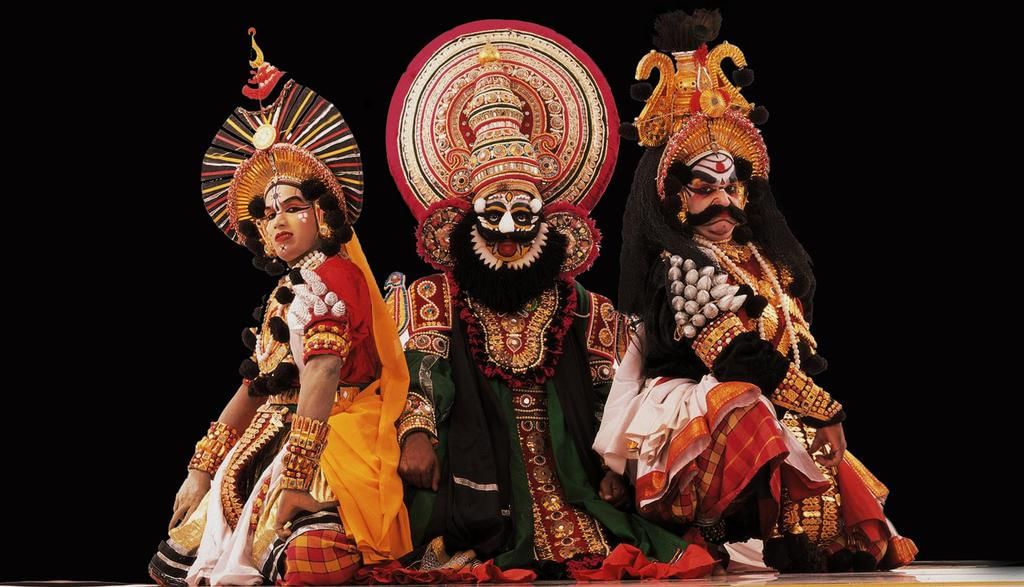 Yakshagana
Yakshagana
2. Burra Katha
- Popular dance-drama tradition of Andhra Pradesh.
- Derives name from Burra - The percussion instrument used extensively during the performance. The performance consists of a main artist or narrator and two vanthas or co-artists who provide rhythm as well as the chorus.
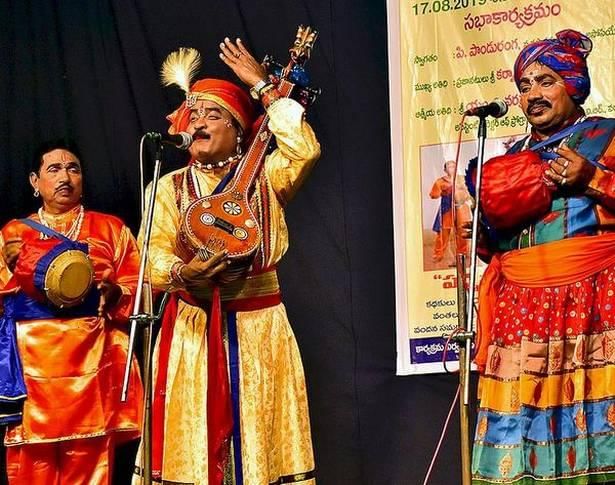 Burra Katha
Burra Katha
3. Pagati Veshaalu
- Popular in Telangana region & Krishna district of Andhra Pradesh.
- Primarily a role-playing act, revolving around a principal character known as vesham (disguise) & other sub-characters.
4. Bayalata
- Open-air theatre tradition of Karnataka.
- Performed during the worship of the local deity.
- Five types of Bayalatas - Dasarat, Sannata, Doddata, Parijata and Yakshagana.
- Stories based on the love of Radha-Krishna.
- Parijata & Yakshagana are narrated by a single Sutradhar while other three forms are performed in a chorus of three-four, aided by a Vidushaka.
 Bayalata
Bayalata
5. Tal-Maddale
- Tal- a kind of cymbal & Maddale- a kind of drum.
- A considered predecessor of Yakshagana.
- Performed while sitting & without any costumes, dance or acting.
- Narration is done by a Bhagavata who is aided by a group of Arthadharis.
6. Theyyam
- Performed in Kerala.
- Similar to Bhuta Kola in Karnataka.
- Open theatre and performed in front of the local temples to honour the spirit of ancestors.
- Themes of Vaishnavism, Shaktism, and Shaivism are now common.
- Actors wear elaborate headgear & colourful costumes.
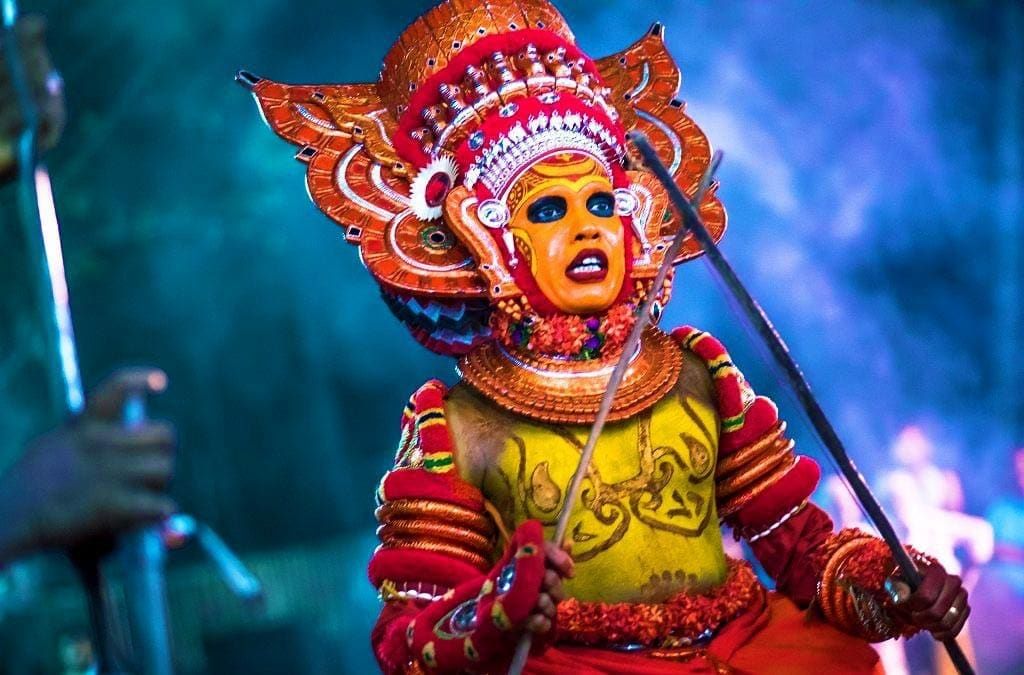 Theyyam
Theyyam
Question for Nitin Singhania: Summary of Indian Theatre
Try yourself:Which of the following theatre form finds its mention in Sangam literature?
View Solution
7. Krishna Attam
- Colourful dance-drama tradition of Kerala.
- Originated in the mid 17th century.
- Based on works of Krishna Geethi.
- It is a carnival that lasts for eight days, with performances in eight consecutive nights narrating the story of Sri Krishna.
 Krishna Attam
Krishna Attam
8. Kuruvanji
- Originated 300 years ago.
- Characterised by classical Tamil poetry & songs.
- First Kuruvanji- composed by Thirukutarajappa Kaviyar.
- Basic theme- love-struck heroine.
- Kuruvanji means ‘fortune-teller’ who predicts the fate of the heroine.
- Performed in a dance ballet form with Bharatnatyam being the principal dance form in Tamil Nadu.
Question for Nitin Singhania: Summary of Indian Theatre
Try yourself:Which of the following is not correctly matched?
View Solution
Modern Indian Theatre
- India’s post-medieval or modern theatre got shape during the colonial era.
- Availability of translations of Sanskrit texts & Western Classics gave an impetus to the theatre.
- Works of Gotthold Ephraim Lessing and Shakespeare were adapted.
- Western Proscenium style of theatre- emerged in 18th & 19th Century.
- Theatres sprang up in Calcutta in 19th century like Belgachia Natyashala, Shobhabazar Natyashala, etc.
- Indians developed their theatrical style by combining the features of Western & Indian style.
- Theatres also became commercialized.
- Common themes- social evils like dowry, caste system, religious hypocrisy and even political affairs.
- British Government even imposed the Dramatic Performances Act in 1876 to counter the growing political awareness.
- Parsi Theatres- famous in Western India during the 1850s-1920s- plays were written in regional languages like Gujarati & Marathi. Colourful backdrops and music were essential. The themes were romance, humour, melodrama, etc.
- From the 1930s, with the advent of cinema, Parsi producers went into film-making.
- Regional theatres of Bengal, Maharashtra etc, also gained prominence.
- Rabindranath Tagore, a celebrated playwright wrote his first play at the age of 20, Valmiki Pratibha.
- His famous works- Roktokoribi (Red Oleanders), Chitrangada, Post-Office, etc.
- His themes- nationalism, spirituality, socio-political situation, etc.
- Other personalities- Prasanna Kumar Thakur, Girish Chandra Ghosh, Deenabandhu Mitra (Nildarpan), etc.
- Prithvi Theatre - established in 1942, by Prithviraj Kapoor. Was a moving theatre with an entourage of 150 artists & held more than 2000 plays.
- In 1978 a permanent theatre was opened in Mumbai and it still exists.
- In 1943, the Indian People’s Theatre Association (ITPA) was formed, as a cultural wing of the Communist Party.
- Was disbanded in 1947, it played an important role in the further development of theatre.
- Their themes- Bengal Famines, etc.
- Notable personalities (ITPA)- Balraj Sahni, Prithviraj Kapoor, Bijon Bhattacharya, Ritwik Ghatak, Utpal Dutt, etc.
- IPTA exists in Chattisgarh, Punjab, and West Bengal.
- Kalakshetra Manipur- formed by Heisnam Kanhailal in 1969 in Manipur to keep the traditional theatre alive.
- Ratan Thiyam established Chorus Repertory Theatre in 1976.
- Establishment of Sangeet Natak Akademi (Music and Performing Arts Akademi) in 1952- For promoting performing arts including theatre gave a further impetus to the development of theatre in India.
- National School of Drama under Ibrahim Alkazi- produced great theatre personalities.
- Samsa (Sami Venkatadri Iyer) and Adya Rangachary are noted Kannada dramatist and playwright.
- Kuppali Venkatappa Puttappa (Kuvempu)- noted actor, playwright of Karnataka.
- Nadu, Veeresalingam Pantulu of Andhra Pradesh. Sreekandan Nair of Kerala, Bharatendu Harishchandra & Jaishankar Prasad.
- BV Karanth- known for his contribution to Andhra, Karnataka and Madhya Pradesh theatre.
- KV Subbanna- formed the acclaimed NINASAM theatre group and is also a winner of Ramon Magsaysay award.
- Other noted modem personalities are- Indira Parthasarathy, Girish Karnad, Habib Tanvir, Vijay Tendulkar, Badal Sarkar, Vijaya Mehta, Dharmavir Bharati, Mohan Rakesh, Chandrashekhar Kambar, and P. Lankesh.
Question for Nitin Singhania: Summary of Indian Theatre
Try yourself:Tamasha is the folk theatre of:
View Solution
The document Nitin Singhania: Summary of Indian Theatre | Additional Study Material for UPSC is a part of the UPSC Course Additional Study Material for UPSC.
All you need of UPSC at this link: UPSC
|
20 videos|561 docs|160 tests
|
FAQs on Nitin Singhania: Summary of Indian Theatre - Additional Study Material for UPSC
| 1. What is Classical Sanskrit Theatre? |  |
| 2. What is Folk Theatre? |  |
Ans. Folk Theatre, also known as traditional or regional theatre, is a form of theatre that is deeply rooted in the cultural traditions and customs of a particular region or community. It is performed by local artists and often incorporates music, dance, and storytelling. Folk Theatre plays a significant role in preserving and showcasing the cultural heritage of a community, and it reflects the social, religious, and historical aspects of the region.
| 3. How does Modern Indian Theatre differ from Classical Sanskrit Theatre? |  |
Ans. Modern Indian Theatre differs from Classical Sanskrit Theatre in terms of language, themes, and presentation style. While Classical Sanskrit Theatre is performed in the Sanskrit language and focuses on ancient Indian epics and mythology, Modern Indian Theatre is performed in various regional languages and explores a wide range of contemporary themes and social issues. Modern Indian Theatre also incorporates experimental techniques and contemporary stagecraft.
| 4. What are some key features of Indian Theatre? |  |
Ans. Indian Theatre is characterized by its diversity, regional variations, and rich cultural heritage. Some key features of Indian Theatre include the use of music, dance, and storytelling, elaborate costumes and makeup, and the incorporation of traditional and folk elements. Indian Theatre also reflects the country's social, religious, and historical aspects and often serves as a platform for addressing contemporary issues and promoting cultural exchange.
| 5. How does Indian Theatre contribute to the cultural heritage of India? |  |
Ans. Indian Theatre plays a crucial role in preserving and promoting the cultural heritage of India. It showcases the diverse traditions, customs, and artistic expressions of different regions and communities. Indian Theatre also serves as a platform for storytelling, conveying moral and philosophical messages, and reflecting the social, religious, and historical aspects of the country. It is an integral part of Indian identity and contributes to the overall richness and diversity of the nation's cultural heritage.
Related Searches


